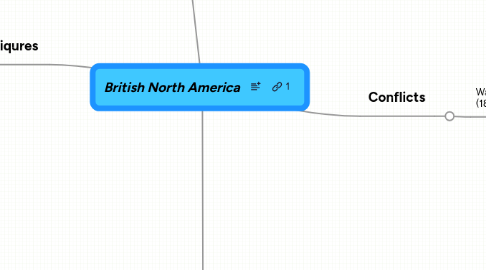
1. Change
1.1. Canada United
1.1.1. On 1841, Canada West and Canada East was united into the Province of Canada, which was under British rule/control
1.1.2. In 1867, the British North America Act split Canada into it's 1841 parts, renaming Canada East Quebec and Canada West Ontario
1.1.2.1. In 1870, Manitoba joined Canada
1.1.2.2. In 1871, British Columbia joined Canada
1.1.2.3. In 1873 Prince Edward Island joined Canada
1.1.2.4. In 1949, Newfoundland joined Canada
1.2. Government
1.2.1. Responsible government was granted after many riots and rebellions led by Papineau, William Lyon Mackenzie, and various others
2. Key fiqures
2.1. Lord Durham
2.1.1. Lord Durham, John Lambton, was known as a very successful leader as he united the Canada's as one and gave them responsible government. Sent from England to investigate recent rebellions by Mackenzie and Papineau, he arrived and was very supportive of the responsible government. Although he was supportive of it, he was biased towards the British and gave the French very little. Some reasons include that he wanted to assimilate the French into the British, and was always the opposite/opposing force of the Union Act
2.2. Issac Brock
2.3. Tecumseh
2.3.1. A Shawnee leader and a First Nation Coalition leader, Tecumseh was a very successful leader. Known for his actions in protecting First Nation lands by allying with the British, Tecumseh fought for many First Nation rights such as land and rights.
2.4. Rebellion Leaders/Anti-Rebellion Leaders
2.4.1. Louis-Joseph Papineau
2.4.1.1. Papineau, 1786-1871, was a politician, lawyer, and landlord of a seigeurnie. He was the leader of a Patriote movement in Lower Canada that demanded responsible government in Canada. Although wanting it as a peaceful strike, it soon got violent as rebellions began to break out. He rallied an violent reform before going into exile into the US
2.4.2. William Lyon Mackenzie
2.4.2.1. Mackenzie, 1795-1861, was a journalist, politician, and rebellion leader. Owning a small printing press, Mackenzie often published insults against leaders in his newspaper. One particular thing that was important in forming Canada was that he began to rally men to fight for responsible government. Rallying his troops to Montgomery's Tavern, he hesitantly waited for 3 more days, thus delaying his attack on York, which would've led to an earlier responsible government. As he waited for more men, Bond Head, an anti-rebellion leader, led many troops to Montgomery's Tavern, killing many rebels and burning it down. Mackenzie then fled to the US in exile, and returned later. His 2 right hand rebel leaders were unsuccessful, and were caught and hanged for treason
2.4.3. Bond Head
2.4.3.1. Head, 1793-1875, was Lieut. Governor of Canada during the rebellions. Angered by the rebellions by Mackenzie, he led troops to Montgomery's Tavern, burning it down and killing many rebels.
3. Tension between different groups
3.1. First Nations demanded that they regain their land and that they get control of Ohio Valley
3.1.1. The First Nations were given back more power and some land were promised to them
3.2. Quebecois demanded that they get back more rights and regain more power
3.2.1. The French were given back more power and many rights were given back to the Quebecois, such as the return of seigneural system
3.3. 13 colonies demand that they get Ohio Valley and more area to expand
3.3.1. The British did not do much but instead increased taxes and created more laws
4. Conflicts
4.1. War of 1812 (1812-1815)
4.1.1. Tension between British and American Forces
4.1.1.1. Trade interferences
4.1.1.1.1. The British created trade laws that ignored international laws
4.1.1.1.2. The British restricted trade between the United States and France
4.1.1.2. American Jingoism
4.1.1.2.1. Americans continually harassed the British
4.1.1.3. British Impressment
4.1.1.3.1. The British impressed (Forced) any British sailor on board an US ship to work for them
4.1.1.3.2. The US accepted the immigration of others into US citizenship
4.1.1.4. British promised Aboriginals land
4.1.1.4.1. The British, who were long time allies of many First Nations, proposed a neutral state for Natives
4.1.1.4.2. The Americans, who were already involved in the War of 1812, invaded the lands on the fall of 1814, thus the British losing the promised lands
4.1.2. 2 different belligerents
4.1.2.1. American Coalition
4.1.2.1.1. Americans
4.1.2.1.2. First Nation Allies
4.1.2.1.3. Strength
4.1.2.2. British Coalition
4.1.2.2.1. British
4.1.2.2.2. First Nations
4.1.2.2.3. French Canadiens
4.1.2.2.4. Strength
4.1.3. Conflicts and blood-shedding battles
4.1.3.1. Casualties of war
4.1.3.1.1. British
4.1.3.1.2. American
4.1.3.2. Battles
4.1.3.2.1. Battle of Queenston Heights
4.1.3.2.2. Battle of Lake Erie
4.1.3.2.3. Battle of Thames
4.1.3.2.4. Battle of Chrysler's Farm
4.1.3.2.5. Battle of Lundy's Lane
4.1.3.2.6. Battle of Lake Champlain
4.1.3.2.7. Battle of York
4.1.3.2.8. Siege of Detriot
